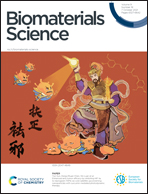A novel lanthanide-based NIR-II nanoprobe for lung squamous cell carcinoma identification†
Abstract
The morbidity and mortality of lung cancer, particularly squamous cell carcinoma and non-small-cell lung cancer (NSCLC), is significantly higher than other malignant tumors. Currently, there is a lack of a real-time, nonradioactive detection method for early-stage squamous non-small-cell lung cancer diagnosis. In this study, we introduced fluorescence imaging in the second near-infrared (NIR-II) window to identify in vivo lung squamous cell carcinoma for the first time. A novel nanoprobe is constructed based on downconversion nanoparticles (DCNPs) with a fluorescence core (NaErF4) and an inert shell (NaYF4) coated via the successive layer-by-layer strategy. The existence of the inert shell reduces the surface defects of DCNPs and inhibits the solvent-quenching effect. Therefore, hydrophilic DCNPs exhibit strong NIR-II fluorescence. After modification with an efficient antibody to the squamous cell carcinoma antigen, DCNPs@anti-SCCA nanoprobes exhibited low cytotoxicity and good biocompatibility. These probes can accurately identify lung squamous carcinoma with high tumor-to-normal-tissue ratio as well as high spatial resolution.



 Please wait while we load your content...
Please wait while we load your content...